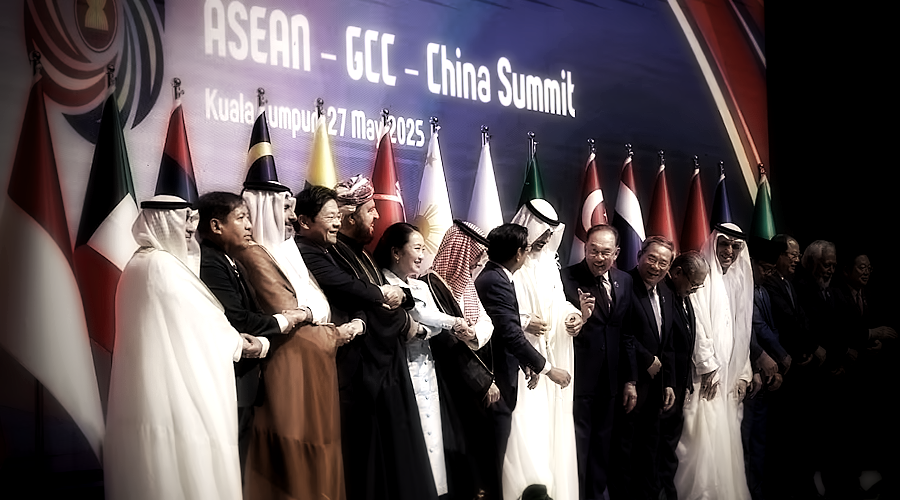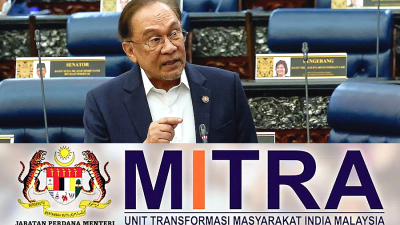
In mid-2025, discussions have emerged describing a massive economic bloc, sometimes called a “$25 trillion alliance,” involving China, ASEAN, and the Gulf Cooperation Council (GCC).
Whether as an informal strategic geometry or a newer configuration of trade, investment and diplomatic alignment, such an alliance spotlights the shifting balance of global power, especially in trade, supply chains and economic influence.
For ASEAN and in particular Malaysia, the formation and mobilization of such an alliance carries both opportunities and risks.
This op-ed analyzes the geopolitical implications for ASEAN, details Malaysia’s current and potential strategic initiatives, and recommends how Malaysia might seize upon the geoeconomics implications going forward.
Geoeconomic context: What is the $25 trillion alliance?
Recent reporting frames this “alliance” as effectively the combined economic power of China, ASEAN, and GCC, pulling together into new or expanded platforms of cooperation.
Some of its foundations rest within the Regional Comprehensive Economic Partnership (RCEP)—which includes ASEAN members, China, Japan, South Korea, Australia, and New Zealand—and related trade, investment, and infrastructure integration initiatives.
The figure of $25 trillion refers to the combined GDP of member states configured through RCEP and adjacent alliances.
It suggests a bloc roughly comparable to, or in some dimensions surpassing, other major trading groupings like G7 or BRICS.
This emerging alignment dovetails with global pressures: supply chain reorganization, trade wars (notably US-China), technology competition, climate and energy transition, and growing emphasis on digital economies.
ASEAN has been positioning itself in this changing landscape.
Geopolitical implications for ASEAN
1. Shift in trade and investment flows
ASEAN stands to benefit from increased inward investment, infrastructure financing and trade linkages, particularly from China and GCC nations.
Projects under the Belt and Road Initiative (BRI), infrastructure in energy, logistics, ports and digital infrastructure may see acceleration.
However, there is a risk element where dependence on fewer major investors or overreliance on China could lead to vulnerabilities (as instances, geopolitical leverage, debt, technology dependencies).
2. Need for regulatory and institutional upgrading
To participate fully, ASEAN countries must harmonize regulations, improve regulatory certainty and upgrade institutional quality.
Issues such as tariff barriers, non-tariff measures, customs facilitation, intellectual property, data governance and digital regulation shall become critical priorities.
ASEAN’s own initiatives like the Digital Economy Framework Agreement (DEFA) are central to this underlying initiative.
3. Geopolitical balancing
The rise of this alliance offers ASEAN a chance to diversify its geopolitical relationships, reducing overdependence on any single great power.
However, with that posture comes pressure: balancing relations with China, the US, GCC states and other power centers such as the EU, Japan, India and others.
ASEAN will need to navigate diplomatic sensitivities carefully, particularly in areas like security, technology transfer and standards.
4. Addressing global fragmentation and trade disruption
The alliance may help ASEAN shield itself from unilateralism (tariff impositions, trade restrictions), especially in US-China tensions.
ASEAN’s Geoeconomics Task Force, for instance, aims to assess risks and propose collective responses.
5. Opportunity for upgrading value chains
With demand shifts and supply chain reorientation, ASEAN members (including Malaysia) can capture greater segments of manufacturing, especially in high tech or intermediate goods.
This can lead to industrial upgrading, skill development and better integration.
Malaysia: Current initiatives and strategic positioning
Malaysia is relatively well-placed within ASEAN with diversified trade, a reasonable institutional base and strategic location.
Several initiatives are already underway, and more are possible. One such example is the Johor-Singapore Special Economic Zone (SEZ) collaborating with incentives, cross-border movement, targeting high value projects and job creation, besides leveraging Singapore’s strengths to attract more multinational investors enabling high-skill employment.
Another is the Free Trade Agreements and GCC/UAE Engagements where Malaysia is positioning as a gateway for GCC investment in Asia, ensuing access to capital, new markets, opportunity in sectors like EVs, digital and sustainable energy.
Risks and challenges Malaysia must manage
Debt and financial risk: Infrastructure financing must be done carefully to avoid unsustainable debt burden, especially under opaque terms.
Regulatory mismatch and standards divergence: Different regulatory standards across countries (safety, quality, data, environment) may slow down integration.
Political and governance stability: Investors care about policy consistency, rule of law, corruption, labor standards and institutional transparency.
Human capital and infrastructure gaps: To move up the value chain, Malaysia must invest in skills, R&D, digital infrastructure, logistics and energy reliability.
Balancing relations with major powers: Aligning too closely with one geopolitical bloc may lead to trade or diplomatic backlashes from others.
Strategic recommendations: Seizing the geoeconomic moment
To fully leverage the formation of the $25 trillion bloc or alliance, Malaysia should pursue a multi-pronged strategy. Below are suggested initiatives:
1. Deepen ASEAN integration with a focus on quality of growth
Push for completion and implementation of DEFA with strong but realistic data governance, cybersecurity and cross-border data flow agreements.
Support harmonization of standards (product, environment, labor) in ASEAN to attract high value investors.
2. Enhance public-private partnerships (PPPs) and local firms’ capabilities
Encourage domestic firms to partner with multinationals in KOCs (key opportunity chains) such as semiconductors, EV supply, clean energy and digital services.
Facilitate technology transfer, joint R&D.
3. Strengthen infrastructure and logistics connectivity
Improve physical infrastructure (ports, rail, roads) especially linking with China and GCC-invested corridors.
Enhance energy diversification, including sustainable energy production (e.g., Malaysia’s plan for sustainable aviation fuel) to meet both domestic demand and export potential.
4. Regulatory reform and institutional capacity building
Ensure consistency in laws, reduce bureaucratic red tape, strengthen judicial independence and fight corruption.
Improve ease of doing business, protect intellectual property rights, streamline customs and trade facilitation.
5. Diversify markets and build resilience in trade
While partnering with China and GCC, also cultivate relationships with the EU, India, Japan and other Global South countries.
Use FTAs smartly to ensure market access, investment inflows, but also guard domestic industries via targeted policies.
6. Human capital and innovation buildout
To invest in education, technical and vocational education training (TVET), especially in digital, advanced manufacturing and green tech.
Support startups, incubators, innovation ecosystems. Link Malaysia’s universities and research institutes more closely with industry.
7. Strategic use of foreign aid, climate and energy funds
Malaysia can tap into climate finance (from multilateral banks, partner countries), green bonds, to fund sustainable infrastructure and renewable energy.
Policy incentivization for investors in clean energy, circular economy and sustainable agribusiness.
Geopolitical implications: Long-term scenarios
Multipolar economics over bipolarity: ASEAN, via this bloc, could help establish a multipolar economic order, where influence is distributed among China, GCC, ASEAN, EU, etc., reducing hegemonic economic pressures from any single power.
Reduced trade vulnerability: With intra-bloc supply chains and diversified markets, ASEAN can better withstand economic shocks from, say, US tariff changes or supply chain disruptions.
Digital and green leadership opportunity: By leading in digital economy frameworks, sustainable energy, and climate finance, ASEAN members (Malaysia included) may become standard-setters, not just followers.
Soft power gains: Such alliances often imply more collaboration in culture, education, environmental diplomacy, which can raise ASEAN’s geopolitical profile globally.
Potential for friction: Alignments like this can cause tensions with other blocs (e.g. if the US seeks counter-alliances), or trigger protective measures, ideological differences, and competing regulatory regimes. ASEAN will need nimble diplomacy.
Conclusion
The “$25 trillion economic alliance” encompassing China, ASEAN, and GCC presents a powerful geoeconomic shift.
For ASEAN, it means an opportunity to upgrade trade, investment, and infrastructure linkages, reduce vulnerabilities, and play a more central role in global governance.
For Malaysia, the moment is ripe to double down on initiatives already underway—DEFA, geo-economics task forces, SEZs with neighbors, FTAs—while pushing further on innovation, institutional quality and resilient infrastructure.
If Malaysia acts strategically, it can not only participate in this emerging bloc, but also help shape it in ways that benefit its economy, society and sovereignty.
(CS Loh is a retired private higher education institute lecturer, postgraduated as an development economist with reference to Southeast Asia from the School of Oriental and Asian Studies (SOAS), University of London.)
ADVERTISEMENT
ADVERTISEMENT









































